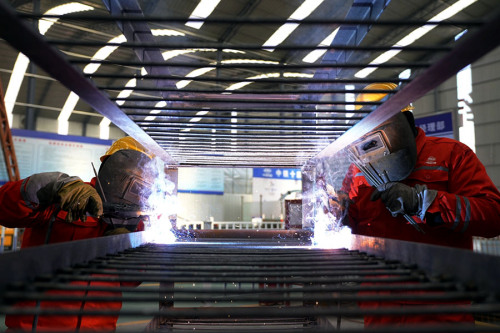
Workers weld a steel structure for a new highway linking Beijing's Yanqing district and Chongli district in Zhangjiakou, Hebei Province. (Photo/Xinhua)
Although hosting the Olympic Games usually presents a heavy workload, the groundwork for Beijing 2022 will be effortless, thanks to the legacy of the 2008 Summer Olympics.
According to the organizing committee, there will be 26 competition and noncompetition venues in the three zones.
Of the 12 venues in Beijing's downtown, where all the ice events will be staged, 11 were built for the 2008 Summer Games or earlier events.
Landmark 2008 venues, including the National Stadium, better known as the Bird's Nest, the National Aquatics Center, aka the Water Cube, and the Wukesong Arena, will be repurposed to host events such as ice hockey and curling, in addition to acting as media and broadcasting centers in 2022.
The only new permanent venue in the Beijing downtown zone will be the National Speed Skating Oval for long-track speed skating, scheduled for completion next year. It will feature post-Olympics operations involving private stakeholders for public skating, hockey games and entertainment events.
"Beijing 2022 can set a new benchmark for sustainable Olympic Games-on the one hand benefiting from the legacy of Beijing 2008, while on the other developing your winter sports facilities in a sustainable way," said IOC President Thomas Bach during Pyeongchang 2018.
Future challenges
As a new competitor and organizer in snow sports, the mainstay of the Winter Olympics, China will face stiff challenges in producing Olympic-standard facilities for snow events in Yanqing and Zhangjiakou by 2022, and ensuring that they are busy after the Games.
Though China has set a target to involve 300 million people in winter sports by 2022, the relatively small number of participants at present and a lack of international skiing competitions mean ensuring post-Olympics use of the facilities is a tougher mission than preparing them for the Games.
"Rather than regarding it as a challenge, we'd better embrace it as an opportunity to make up for the lack of winter sports facilities to meet the growing public demand for more diversified exercise activities," said Yang, who was appointed chairwoman of the athletes' commission of the Beijing 2022 organizing committee in November.
Chongli district in Zhangjiakou, where most of the snow events will be staged, has integrated preparatory work for the Games into a plan to develop the mountainous region-home to seven commercial ski resorts-into a skiing and winter tourism destination.
Of the 76 projects for 2022 in the region, 43 are under construction and a further 22 will get underway this year, while work will start on the remaining 11 venues next year, according to Wu Weidong, mayor of Zhangjiakou.
"To not only meet demand for the Games, but also the future industry, we still have to improve a lot in terms of high-level competition management, energy supplies, medical services and accommodation for snow sports," said Wu, an NPC deputy.
Complex problems
Advisers also stressed that the complexity of venues for highly technical events, such as ski jumping and alpine skiing, requires planning for post-event operations, based on local conditions and international expertise.
Citing the ski jumping hills at the training center at the Pajulahti Sports Institute in Finland as an example, Shen Jin, a CPPCC member, said the facility for 2022 should cater for functions other than just the ski jumping event.
"It's always difficult to use the high towers and long ramps after the competition. More options for future use in terms of sightseeing, exhibitions and leisure activities are necessary," said Shen, deputy director of the planning and sustainability department of Beijing 2022.
The alpine skiing course, which is being built on Xiaohaituo Mountain in Yanqing, needs about 1,300 people for venue management, event services and medical support, but there are few suitable individuals in China, according to Wang Yanxia, deputy director of the sports department of the Beijing 2022 organizing committee.
To learn this sophisticated line of work, including producing densely packed artificial snow courses and providing alpine medical services, the committee sent 41 staff members to the IOC's Secondment Program to gain hands-on experience by working alongside local hosts at multiple snow venues during Pyeongchang 2018.
"We can afford to hire experienced staff members from overseas for the 2022 Olympics, which will guarantee operations," Wang said.
"But our goal is to take the opportunity to train as many local experts as possible. They will become the human legacy of our winter sports industry."


















































